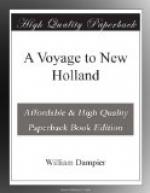We also saw many bunches of seaweeds in the latitude of 39 32 and, by judgment near, the meridian of the island Tristan d’Acunha: and then we had about 2 degrees 20 minutes east variation: which was now again decreasing as we ran to the eastward, till near the meridian of Ascension; where we found little or no variation: but from thence, as we ran farther to the east, our variation increased westerly.
Of A bird that shows the cape of good hope to be near: Of the sea-reckonings, and variations: And A table of all the variations observed in this voyage.
Two days before I made the Cape of Good Hope my variation was 7 degrees 58 minutes west. I was then in 43 degrees 27 minutes east longitude from Cape Salvador, being in latitude 35 degrees 30 minutes, this was the first of June. The second of June I saw a large black fowl, with a whitish flat bill, fly by us; and took great notice of it, because in the East India Waggoner, pilot-book, there is mention made of large fowls, as big as ravens, with white flat bills and black feathers, that fly not above 30 leagues from the Cape, and are looked on as a sign of one’s being near it. My reckoning made me then think myself above 90 leagues from the Cape, according to the longitude which the Cape hath in the common sea-charts: so that I was in some doubt whether these were the right fowls spoken of in the Waggoner; or whether those fowls might not fly farther off shore than is there mentioned; or whether, as it proved, I might not be nearer the Cape than I reckoned myself to be; for I found, soon after, that I was not then above 25 or 30 leagues at most from the Cape. Whether the fault were in the charts laying down the Cape too much to the east from Brazil, or were rather in our reckoning, I could not tell: but our reckonings are liable to such uncertainties from steerage, log, currents, half-minute-glasses; and sometimes want of care, as in so long a run cause often a difference of many leagues in the whole account.
Most of my men that kept journals imputed it to the half-minute-glasses: and indeed we had not a good glass in the ship beside the half-watch or two-hour-glasses. As for our half-minute-glasses we tried them all at several times, and we found those that we had used from Brazil as much too short, as others we had used before were too long; which might well make great errors in those several reckonings. A ship ought therefore to have its glasses very exact; and besides, an extraordinary care ought to be used in heaving the log, for fear of giving too much stray line in a moderate gale; and also to stop quickly in a brisk gale, for when a ship runs 8, 9 or 10 knots, half a knot or a knot is soon run out, and not heeded: but to prevent danger, when a man thinks himself near land, the best way is to look out betimes, and lie by in the night, for a commander may err easily himself; beside the errors of those under him, though never so carefully eyed.




